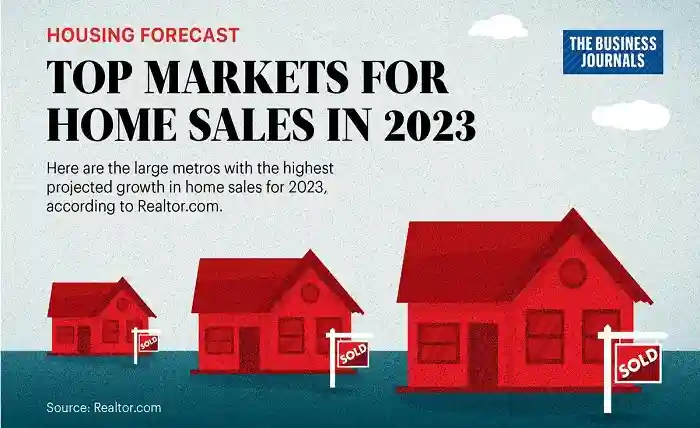Real Estate Housing Market 2023: A Challenging Year for Buyers and Sellers

The real estate housing market in 2023 is expected to be a challenging year for both buyers and sellers, as high mortgage rates, low inventory, and economic uncertainty continue to affect the market. Here are some of the key trends and predictions for the real estate housing market in 2023.
Mortgage Rates: High and Rising
One of the main factors that will impact the real estate housing market in 2023 is the level of mortgage rates, which are projected to remain high and rise further throughout the year. According to Bankrate’s survey of large lenders, the average 30-year fixed mortgage rate was 6.95% as of July 5, 2023. This is almost double the rate from a year ago, when it was 3.72%.
The main reason for the increase in mortgage rates is the Federal Reserve’s monetary policy, which aims to curb inflation by raising the federal funds rate, which is the rate that banks charge each other for overnight loans. The Fed has raised the federal funds rate 10 times since March 2022, from near zero to a range of 5.25% to 5.5%. The Fed is expected to raise the rate at least one more time in 2023, reaching a terminal rate of 5.6% by the end of the year.
Mortgage rates are influenced by the federal funds rate indirectly, as they reflect the expectations and demand of investors in the bond market. Higher interest rates make bonds more attractive than mortgages, which lowers the demand and price of mortgages, and raises their yields or rates. Therefore, as the Fed raises the federal funds rate, mortgage rates tend to follow suit.
Some experts predict that mortgage rates will reach as high as 8.75% for a 30-year fixed loan and 8.25% for a 15-year fixed loan by the end of 2023. Others are more optimistic and expect rates to peak at around 8% for a 30-year fixed loan and 7.25% for a 15-year fixed loan in early 2023, and then gradually decline to around 6% and 5.25%, respectively, by the end of the year.
Read more about canonevent.org
Home Prices: Mixed Signals
Another factor that will affect the real estate housing market in 2023 is the level and trend of home prices, which have shown mixed signals in recent months. According to the National Association of Realtors (NAR), the median existing-home sales price broke through $400,000 for the first time in 2023, hitting $410,200 in May. This is the second-highest price ever recorded, only surpassed by the June 2022 all-time high of $413,800.
The main reason for the increase in home prices is the imbalance between supply and demand in the housing market. On one hand, there is strong demand for homes from buyers who want to take advantage of low mortgage rates (before they rise further), who have accumulated savings during the pandemic, or who have changed their preferences for more space and amenities. On the other hand, there is low supply of homes from sellers who are reluctant to sell due to high transaction costs, lack of alternative options, or fear of exposure to COVID-19.
According to NAR, there were only 1.23 million existing homes available for sale at the end of May, down 20.6% from a year ago. This represents a 2.5-month supply at the current sales pace, well below the six-month supply that is considered a balanced market. As a result, homes are selling fast and at premium prices, with multiple offers and bidding wars being common.
However, some signs suggest that home prices may be slowing down or even declining in some areas. According to Zillow’s Home Value Index (ZHVI), which measures changes in home values across different markets, home prices increased by only 0.7% from April to May, down from a peak monthly growth rate of 1.7% in March. Moreover, some markets saw negative monthly growth rates in May, such as San Francisco (-0.4%), New York (-0.2%), Los Angeles (-0.1%), and Chicago (-0.1%).
The main reason for the slowdown or decline in home prices is the affordability crisis that many buyers are facing due to high mortgage rates and elevated home prices. According to NAR’s Housing Affordability Index (HAI), which measures whether a typical family can qualify for a mortgage loan on a typical home at current interest rates and income levels, affordability declined by 12.1% from May 2022 to May 2023. This means that fewer buyers can afford to buy a home at current prices and rates, which reduces the demand and puts downward pressure on prices.
Some experts predict that home prices will continue to rise in 2023, but at a slower pace than in 2022. According to a survey by Zillow, the average annual home price growth rate for 2023 is expected to be 5.1%, down from 13.6% in 2022. Others are more pessimistic and expect home prices to fall in 2023, especially in markets that are overvalued or vulnerable to economic shocks. According to a report by CoreLogic, 41% of the top 50 U.S. metro areas are overvalued as of May 2023, and eight of them are considered the most fragile housing markets in the country, such as Las Vegas, Miami, Orlando, and Phoenix.
Read more about canonevent.org
Buyer Competition: Still Fierce
A third factor that will impact the real estate housing market in 2023 is the level of competition among buyers, which is expected to remain fierce despite the challenges of affordability and availability. According to NAR, existing homes typically sold in 17 days in May, down from 26 days a year ago. Moreover, 89% of homes sold in May were on the market for less than a month.
The main reason for the high competition among buyers is the low inventory of homes for sale, which creates a seller’s market where buyers have to compete with each other for the limited number of available homes. According to Redfin, a real estate brokerage firm, 74% of homes that went under contract in May faced bidding wars, up from 72% in April and 52% in May 2022. Moreover, the average number of offers per home was 4.8 in May, up from 4.6 in April and 3.4 in May 2022.
Some of the strategies that buyers are using to win bidding wars include offering above the asking price, waiving contingencies, writing personal letters, or making all-cash offers. According to Redfin, the average sale-to-list price ratio, which measures how much higher or lower a home sells compared to its listing price, was 101.7% in May, up from 100.1% in April and 98.3% in May 2022. This means that the average home sold for 1.7% above its asking price in May.
Some experts predict that buyer competition will ease slightly in 2023 as more sellers enter the market and more buyers exit the market due to affordability issues or changing preferences. According to Zillow’s survey, the average number of offers per home is expected to decline from 4.8 in May to 4.0 by December. Others are more skeptical and expect buyer competition to remain high or even increase in 2023 as demand continues to outstrip supply and buyers try to lock in low mortgage rates before they rise further.
Conclusion
The real estate housing market in 2023 is expected to be a challenging year for both buyers and sellers, as high mortgage rates, low inventory, and economic uncertainty continue to affect the market. Buyers will face high prices, low affordability, and fierce competition for the limited number of available homes. Sellers will face high transaction costs, lack of alternative options, and potential price declines or stagnation in some areas. Both buyers and sellers will need to be flexible, realistic, and well-informed about the market conditions and trends in their local areas.




